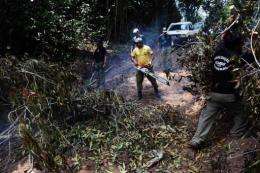US, others commit to restoring damaged forests

The United States, Rwanda and a coalition of Brazilian groups on Monday vowed to restore at least 18 million hectares (45 million acres) of damaged forests.
The commitments are the first in a voluntary initiative launched nine months ago, which aims at restoring 150 million hectares (375 million acres) of deforested and degraded lands by 2020.
Fifteen million hectares (37.5 million acres) will be restored "in 20 forest watersheds, including tribal regions, across the United States," Elise Golan, director of sustainable development at the US Department of Agriculture, told journalists at the "Rio+20" conference.
Two million hectares (five million acres) will be restored in the east African state of Rwanda under a government pledge there, and a million ha. (2.5 million acres) will be restored in the Mata Atlantica forest on the eastern coast of Brazil through a coalition of government agencies, NGOs, corporations and an alliance of indigenous peoples.
The so-called Bonn Challenge was initiated at a German-led ministerial roundtable in September 2011.
The International Union for Conservation of Nature (IUCN), which is supporting the initiative, says that once restored, 150 million hectares (375 million acres) of forest would provide economic benefits of more than $80 billion.
It would also narrow the "emissions gap" -- the difference between current output of climate-altering greenhouse gases and what is needed to bring it to a safer level -- by between 11 and 17 percent.
"The largest restoration initiative the world has ever seen is now truly underway, and will provide huge global benefits in the form of income, food security and addressing climate change," said Julia Marton-Lefevre, the IUCN's chief.
"We urge other countries and landowners to follow suit."
According to the IUCN, two billion hectares (five billion acres) of damaged land also provides good opportunities for reforestation.
Since 1992, coverage of primary forests around the world has shrunk by 300 million ha. (750 million acres), an area almost as big as Argentina. Deforestation is the third biggest source of greenhouse gases.
The biggest losses have been in tropical regions that also have the greatest biodiversity. In the northern hemisphere, reforestation has now overtaken deforestation, though.
In a separate presentation at the UN Conference on Sustainable Development in Rio, the UN's Food and Agriculture Organization (FAO) said 350 million of the world's poorest people, including 60 million indigenous people, depend on forests for their daily subsistence and long-term survival.
It made a pitch for sustainable forestry as a "renewable source of energy," saying wood is still the dominant source of heating and cooking for a third of the world's population.
(c) 2012 AFP




















